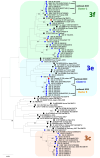The Prevalence, Risk Factors, and Outcomes of Hepatitis E Virus Infection in Solid Organ Transplant Recipients in a Highly Endemic Area of Italy
- PMID: 40284945
- PMCID: PMC12031106
- DOI: 10.3390/v17040502
The Prevalence, Risk Factors, and Outcomes of Hepatitis E Virus Infection in Solid Organ Transplant Recipients in a Highly Endemic Area of Italy
Abstract
Hepatitis E virus (HEV) infection can become chronic in immunocompromised patients, like solid organ transplant recipients (SOTRs). We evaluated HEV prevalence, risk factors, and outcomes among SOTRs in a hyperendemic HEV area. Three hundred SOTRs were enrolled from April to July 2019 and tested for anti-HEV IgM and IgG and HEV RNA. Sixty-three recipients (21%) were positive for any HEV marker. HEV infection was independently associated with older age and pork liver sausage consumption. Three viremic recipients harbored genotype 3e and 3f according to HEV RNA sequencing and phylogenetic analysis. Overall, 10 recipients had markers of active/recent infection (HEV RNA and/or anti-HEV IgM) and were followed up prospectively. Five of them spontaneously resolved their HEV infection. In two recipients, HEV clearance was achieved only through immunosuppression reduction, while three needed ribavirin therapy to achieve virologic resolution. We observed a chronic course in 30% of SOTRs with active/recent HEV infection. No association was found between tacrolimus assumption and chronicization. In conclusion, we found a high prevalence of infection among SOTRs attending a transplant center in a hyperendemic Italian HEV region. Systematic screening for all HEV markers and dietary education for infection control are needed for transplant recipients.
Keywords: HEV; HEV genotypes; HEV–host interactions; antivirals.
Conflict of interest statement
The authors declare no conflicts of interest.
Figures


Similar articles
-
The high burden of HEV infection in solid organ transplant recipients.Hepatol Commun. 2025 Jul 14;9(8):e0740. doi: 10.1097/HC9.0000000000000740. eCollection 2025 Aug 1. Hepatol Commun. 2025. PMID: 40658785 Free PMC article.
-
HEV seroprevalence and associated risk factors among HIV-positive individuals in post-earthquake Kathmandu: a 2016 cross-sectional study.BMC Infect Dis. 2025 Aug 5;25(1):986. doi: 10.1186/s12879-025-11382-8. BMC Infect Dis. 2025. PMID: 40764531 Free PMC article.
-
Heterogeneity in the seroprevalence of hepatitis E virus among hospital attendees: a retrospective study in Shanghai, China.Infect Dis (Lond). 2025 Jul;57(7):647-657. doi: 10.1080/23744235.2025.2471819. Epub 2025 Feb 27. Infect Dis (Lond). 2025. PMID: 40017260
-
Hepatitis E virus seroprevalence rate among Eastern Mediterranean and middle eastern countries; A systematic review and pooled analysis.Microb Pathog. 2017 Sep;110:252-256. doi: 10.1016/j.micpath.2017.06.045. Epub 2017 Jul 5. Microb Pathog. 2017. PMID: 28688980
-
Hepatitis E virus infection in Turkey: a systematic review.Ann Clin Microbiol Antimicrob. 2018 May 2;17(1):17. doi: 10.1186/s12941-018-0269-6. Ann Clin Microbiol Antimicrob. 2018. PMID: 29716597 Free PMC article.
Cited by
-
Seroprevalence of hepatitis E virus among solid organ transplant recipients: insights from southern Iran.Gastroenterol Hepatol Bed Bench. 2025;18(2):205-210. doi: 10.22037/ghfbb.v18i2.3110. Gastroenterol Hepatol Bed Bench. 2025. PMID: 40936785 Free PMC article.
-
Clinical Characteristics and Epidemiological Features of Hepatitis E Virus Infection Among People Living with HIV in Shanghai, China.Viruses. 2025 Jul 25;17(8):1038. doi: 10.3390/v17081038. Viruses. 2025. PMID: 40872754 Free PMC article.
References
-
- Lee G.H., Tan B.H., Teo E.C., Lim S.G., Dan Y.Y., Wee A., Aw P.P.K., Zhu Y., Hibberd M.L., Tan C.K., et al. Chronic infection with camelid hepatitis E virus in a liver transplant recipient who regularly consumes camel meat and milk. Gastroenterology. 2016;150:355–357. doi: 10.1053/j.gastro.2015.10.048. - DOI - PubMed
MeSH terms
Substances
LinkOut - more resources
Full Text Sources
Medical
Miscellaneous

